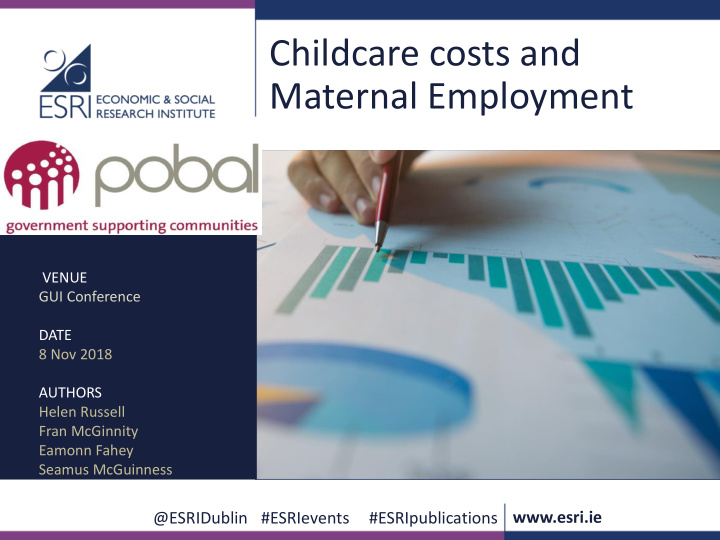



Childcare costs and Maternal Employment VENUE GUI Conference DATE 8 Nov 2018 AUTHORS Helen Russell Fran McGinnity Eamonn Fahey Seamus McGuinness www.esri.ie @ESRIDublin #ESRIevents #ESRIpublications
Motivation & Research Questions • Maternal employment strongly linked to age and number of children. Irl lower than OECD average • Childcare costs regularly cited as a major barrier to employment among mothers – less often measured • OECD data suggests that Ireland one of the highest childcare costs as a proportion of income • How is maternal employment affected by childcare costs in a context of high costs? 8 November 2018 2
Previous Research on Childcare Costs and Maternal Employment • Studies of policy changes/regional variation, to estimate the effects of childcare price (e.g. Brewer et al., 2016; Cascio et al., 2015) • Typically find reduction in costs/increased availability of childcare has positive impacts on mothers’ working hours (Morrissey, 2017) effect smaller in Sweden (Lundin et al 2007) than Spain (Nollenberger Rodriguez-Planas, 2015) • Brewer et al (2016) UK study found introduction of 15 hours of free pre- school did not increase women’s employment but the extension of the scheme to 30 hours per week did have an impact (for the youngest child). • Econometric studies estimate the elasticity of mothers’ employment conditional on wages and the price of formal childcare effect size highly variable ( see review in Akgunduz and Plantenga,2017) 3
Growing Up in Ireland Survey Wave 2 Wave 3 Wave 1 Jan 11 - Aug Mar 13 - Sep Sep 08 - Mar 11 13 09 • Age 3 years • Age 5 years • Age 9 months • N = 11,134 • N = 9,240 • N = 9,793 • Collects information on hours & cost of childcare in each wave • Includes all childcare types, not available elsewhere • Mother’s employment status recorded at each wave www.esri.ie @ESRIDublin #ESRIevents #ESRIpublications 4 8 November 2018
Non-parental care at age 3 (8 hours or more per week) No payment 55% Payment 45% Relative 50% of 23% families using non Centre- parental based Childminder 54% care 23% 5
Costs for parents for study child at age 3 years in 2011: paid care only Excludes those not paying for care 08/11/2018 6
Mothers Employment by Study Child’s Age 100% 8 10 12 90% 17 18 80% 20 70% 16 40 plus hours 19 60% 20 5 30 -39 hours 50% 7 16-29 hours 8 40% 1-15 Hours 30% 54 No Paid Work 46 20% 41 10% 0% 9 Months 3 years 5 years 8 November 2018 7
Mothers Employment by Study Child’s Age • 9% moved between full & part-time • Altogether 45% of women experience changes of 1 hour or more between the 2 periods • Stay-at-home v continuous full-time dichotomy does not capture reality 8 November 2018 8
Modelling Strategy • Challenges – care-costs are positively correlated with social advantage – higher education, social class, hh income. – Need to correct for this or higher costs will be associated with greater likelihood of employment (endogeneity) – Those not working or using care may face greatest disincentive (but have no costs to model) • Solution • Instrumental variable approach for endogeneity (region) • Selection correction model to adjust for the fact that those in employment and using paid care at age 3 differ from those who are not • Model hours at age5 to reduce problem of reverse causality • Dependent variable = paid work hours per week (zero if not employed) • Care costs = log of weekly childcare costs • Controls: age, ed, nationality, health, partner, N children, school. 8 November 2018 9
Effect of childcare costs on subsequent employment Sig negative effect of childcare cost at age 3 on mother’s hours of paid work at age 5. • All else being equal we estimate that on average a – 10% increase in costs leads to decrease of 30 mins paid work per week – 10% decrease in cost leads to increase of 30 mins paid work per week – 50% increase in costs leads to a decrease of 2½ hours paid work This is the average effect of price across all women. Combines effect of exiting, along with changes in hours and cases where there is no change in response to price. 8 November 2018 10
Effect of childcare costs on hours of paid work continued • Significant interaction with household income: higher cost is more negative for those in low income households • Conservative estimate – Only cost for study child. – Other children and birth of new baby has a separate negative effect on working hours, likely partly due to child care costs • How does this compare to other effects? – The birth of a new baby is associated with a reduction of 3.6 hours – Chronic illness is associated with a reduction of 1.7 hours per week 8 November 2018 11
Conclusions & policy implications • Childcare costs are a substantial burden – 12% of disposable income for one child at age 3, before entry to ECCE scheme. • Even higher financial burden for low income & lone parent families • Demonstrates negative impact of care costs on maternal emp. • Suggests additional childcare supports will increase female labour supply. Effects likely to accumulate over time. • Finding that disincentive effect greater for low income families supports case for targeting extra support for this group. • New Affordable Childcare Scheme has universal and income targeted elements, though too early to assess impact. • Employment of mothers important effect in reducing child-poverty (Watson et al. 2012), also increased tax receipts. 8 November 2018 12
Thanks for listening What questions do you have? Report available to download at www.esri.ie/publications/ 13 14 November 2018
Recommend
More recommend